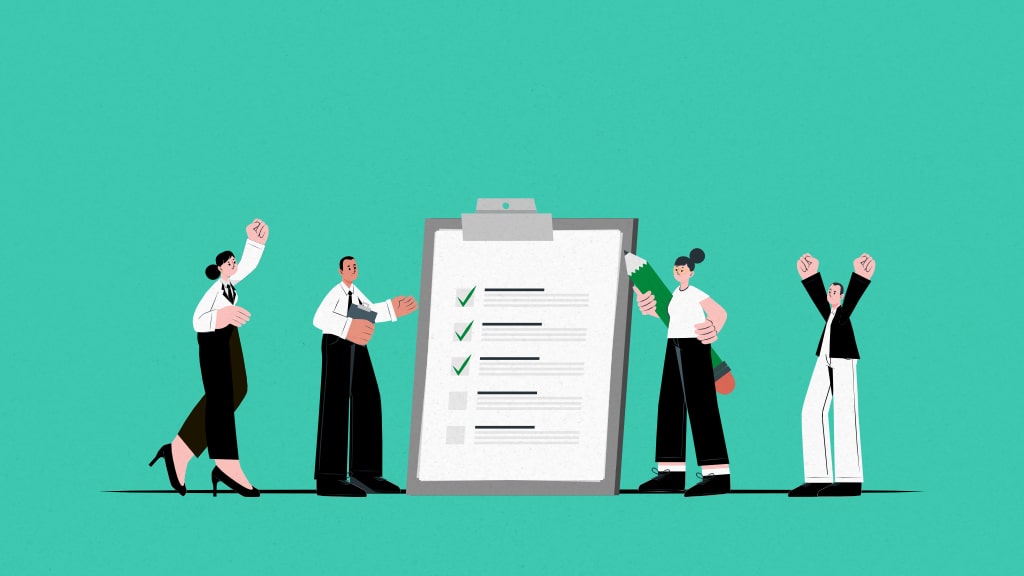The primary purpose of writing a project proposal is to secure funding, gain approval, or secure resources from the most important stakeholders of a project.
For that, you need to explain the following in simple terms in a project proposal:
- What do you want to do and what are your goals for the project?
- How are you going to achieve your goals?
- How are stakeholders going to benefit from the project?
- What do you want from stakeholders?
- How are you going to use the money and resources granted by stakeholders?
In this post, we will learn about all these about writing a perfect project proposal in 2026. We will look at different types of project proposals, a project proposal template, and a real-world example of a project proposal.
What is a project proposal?
A project proposal is a project management document that outlines a project’s objectives, timeline, budget, goals, and requirements.
It is primarily written for stakeholders to secure funding, gain approval, and secure resources. However, other types of project proposals are also sent to win projects from clients.
A project manager should have a good understanding of the project and its key stakeholders for writing an effective project proposal. It is because a manager needs to get into the heads of the project’s stakeholders to understand what they expect from a project and write an effective project proposal accordingly to ensure buy-in for the project.
Benefits of writing a strong project proposal
Writing a strong project proposal offers a surprising number of benefits beyond simply securing funding or approval. Here are five key benefits of writing an effective project proposal:
- Clearly defines the project to increase the chances of success
- Makes it easy for stakeholders to mutually understand the project
- Ensures everyone involved is on the same page about goals, roles, and expectations
- Helps identify potential roadblocks early for proactive planning of solutions
- It can attract funding, and talent, and even serve as a marketing tool
Difference between a project proposal, a project charter, and a project plan
It is important to note that a project proposal is different from a project charter and project plan. Let’s understand the difference between these terms.
Project proposal vs. project charter
A project charter is a formal document that outlines the project’s goals, objectives, and resource requirements for a shared understanding of the team. It can’t be created until the project proposal is approved. Whereas a project proposal is written during the initiation phase.
Project proposal vs. project plan
A project plan is a detailed guide that provides step-by-step instructions for executing, monitoring, and managing the approved project. It is created during the planning stage after the project charter and project scope is defined. Whereas, a project proposal is a persuasive tool for securing project approval and resources.
Read more: Project management plan – everything you need to know about
Project proposal types
Project proposals are of six different types. Each has a different goal. A manager may have to write a project proposal for external and internal stakeholders to run a project successfully. Therefore, it is important to know about the different types of project proposals.
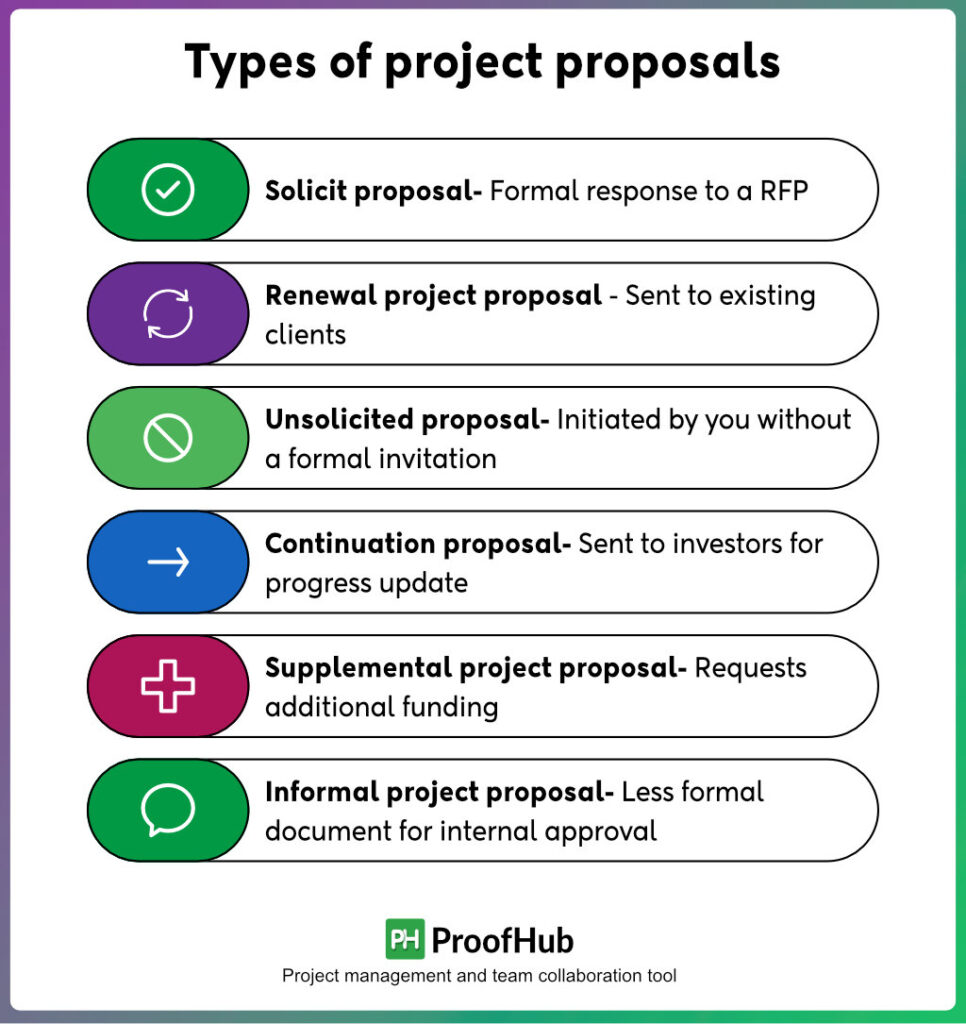
1. Solicited project proposal
A solicited project proposal is sent in response to a request for proposal (RFP). RFP is a document sent by a company to vendors to seek out resources required for a project. It includes the details of the scope of the work and the payment company pays for the resources.
RFP is sent to many vendors. Thus, while writing a solicited project proposal, you need to keep in mind that you may be competing against other vendors to secure a project. Thus, you need to keep your tone persuasive.
2. Unsolicited project proposal
This type of proposal is sent without having received a request for a proposal (RFP). A company has not sent a request for proposal to vendors but you know that the company is seeking resources from third-party vendors. You may or may not be competing against the other vendors in this type of proposal.
3. Informal project proposal
It is a type of project proposal that is created when a client makes an informal request for a project proposal from vendors. It means there is no formal RFP. Thus, the rules for writing a project proposal are less concrete. You can follow any format that can secure you a project.
4. Renewal project proposal
A project manager writes this type of proposal to existing clients to extend their services to the client. In this type of proposal, you focus on highlighting past achievements to secure a renewal for the future.
5. Continuation project proposal
The purpose of the continuation project proposal is to inform the client that the project is beginning and communicate the progress. You are not persuading the client with this type of proposal.
6. Supplemental project proposal
As the name suggests, this type of proposal is sent to the stakeholders who are already involved in a project to secure additional resources. The purpose is to convince the client to invest additional resources during the project execution phase.
How to write a winning project proposal?
You need to include certain elements in the project proposal to make sure it is good. Have a look at the steps to learn how to format a project proposal.
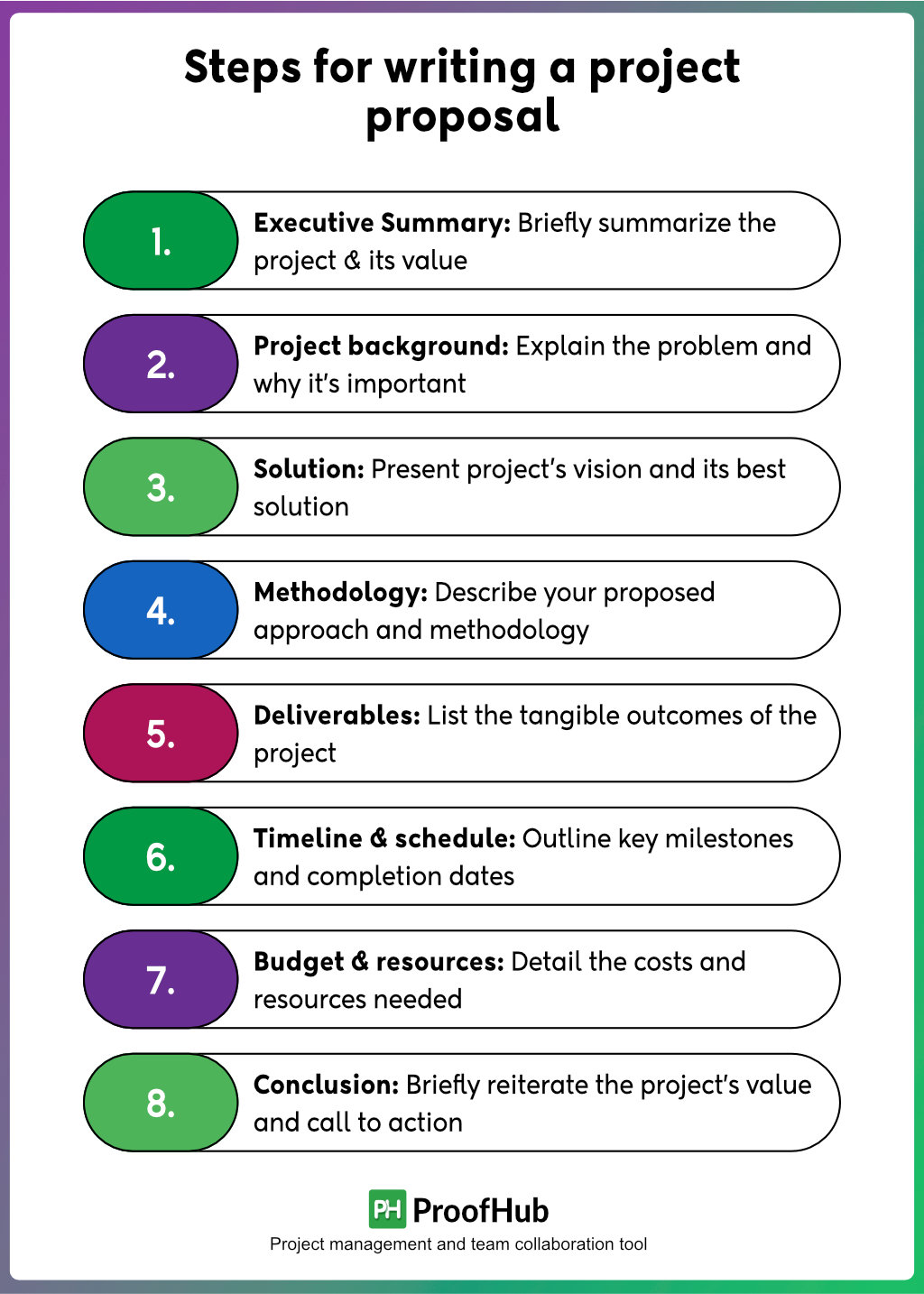
A. Pre-writing stage
The pre-writing stage is crucial for creating a compelling and successful project proposal. Here’s a breakdown of the key steps involved:
1. Understanding the audience
The first step is to identify decision-makers and understand the mindset of the audience for which you are writing a proposal. Thoroughly research the client’s needs, goals, and expectations. This includes understanding their industry, current challenges, and past projects.
Determine who will be reviewing and approving the proposal. This will help you adjust the tone, level of detail, and overall focus to cater to their expertise and interests. Tailor your proposal to directly address their specific concerns and priorities.
2. Project requirements gathering
To create an effective project proposal that has a higher chance of getting accepted, gather the project requirements. Usually, it is mentioned in the Request for Proposal (RFP) where specific requirements, evaluation criteria, submission deadlines, and any other instructions are provided.
If there is no RFP, schedule meetings or interviews with key stakeholders to gain a deeper understanding of the project requirements. This allows you to ask clarifying questions, gather feedback, and ensure your proposal aligns perfectly with their expectations.
3. Team brainstorming
Writing a project proposal is teamwork. Involve your team in brainstorming sessions to make a strong proposal. When a team is involved, it diversifies perspectives and expertise, leading to a more comprehensive and well-rounded proposal. Discuss the project goals, potential solutions, and resource needs with your team. Refine the proposal concept based on the collective knowledge and ensure everyone is aligned on the final approach.
B. Writing the proposal
1. Start with writing an executive summary
An executive summary is a concise overview of what a project is all about. It talks about the most important details or information of the project.
It primarily talks about the problem a project will solve, the solution a project will provide, and the benefits stakeholders will get from investing in this project.
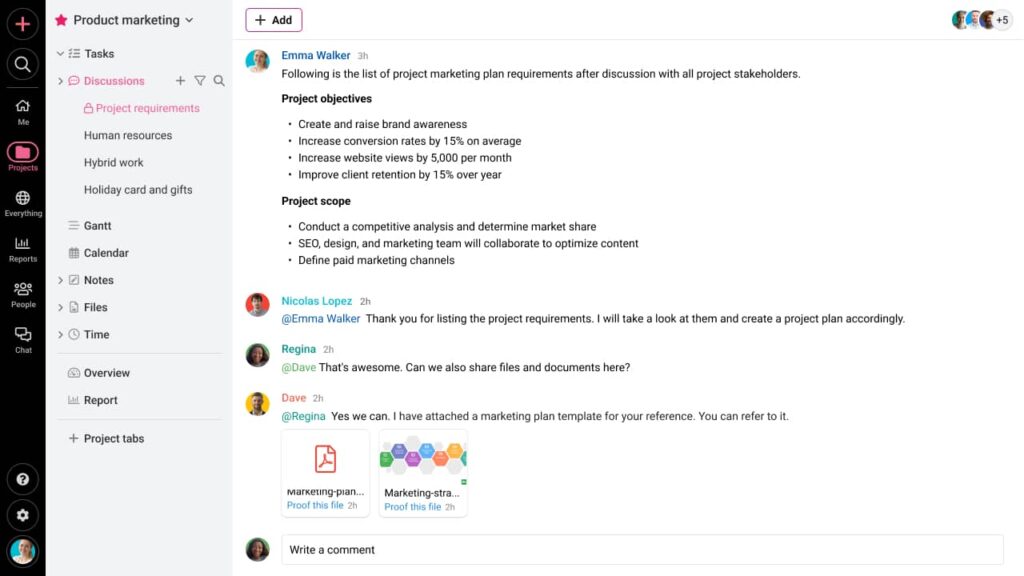
It is important to keep in mind to explain these items briefly as you are going to explain the problem and solution in detail later in your proposal.
The purpose of writing an executive summary is to pique the interest of the stakeholders in a project. It is like the elevator pitch of an entrepreneur whose purpose is to attract the stakeholders for further discussion.
2. Explain the problem in the project background
The project background is a one-page section that focuses on highlighting the opportunity by talking about the project problems you are going to solve. It talks about the problem and its history such as statistics, references, and start date.
It discusses what has been done so far to solve the problem by others or earlier projects. What is the current state of the problem, and how your project will focus on solving it?
This section indicates the opportunity and the next section of vision explains how you are going to seize the opportunity.
3. Project vision and solution
Project vision is the section where you present the solution to the problem. Vision statement defines your vision for the project, the solution you are going to work on, and how it will solve the problems.
This section tells what goals and objectives you are going to achieve from the project. Thus, it also acts as a north star or success criterion for your project.

Now, stakeholders know what a project is all about; the problems, the solution, and the objectives. And they are interested to know how you will achieve the proposed objectives of a project.
The next sections of a project proposal talk about the project approach, scope, deliverables, milestones, budget, resources, and timeline.
Read more: Project objectives: learn how to write them for business growth
4. Project scope and deliverables
This section describes all the work items you need to work on a project. It involves breaking a large project into small tasks so that stakeholders can easily understand the project scope.
It also includes describing key milestones and project deliverables during the execution phase of your project life-cycle.
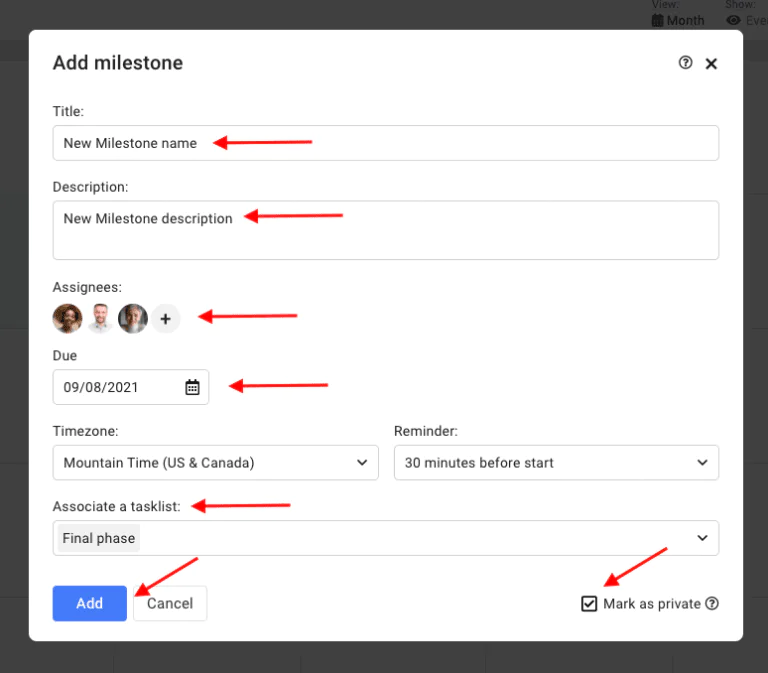
The purpose is to provide stakeholders with enough information to make decisions about funding and resources.
5. Project timeline
Project stakeholders have a clear idea about the scope of the project. But the very next question that comes to stakeholders’ minds is how much time a project will take to complete.
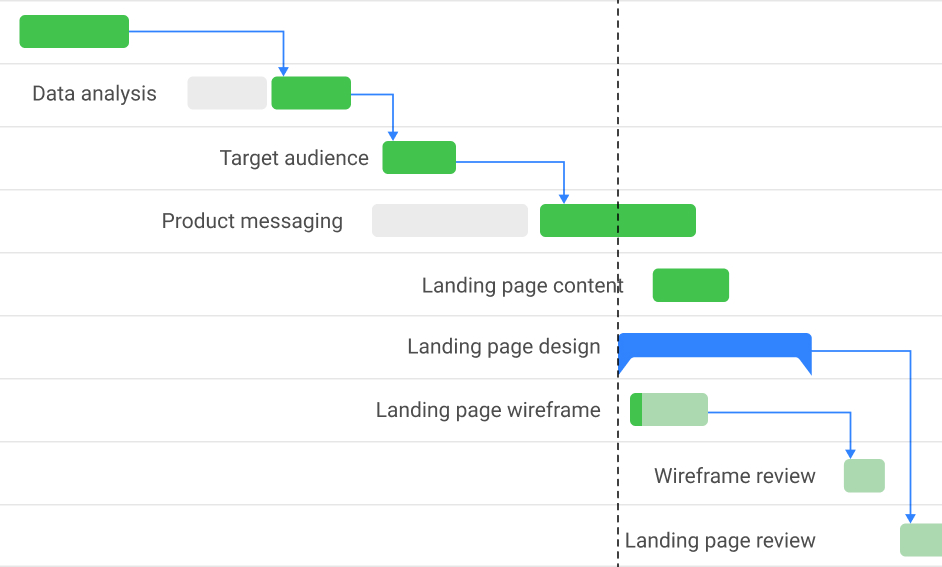
You need to propose an estimated timeline for the project describing when the key deliverables and milestones will be delivered and achieved.
6. Project methodology
With every project, the risks of cost, scope, time, and quality are associated. Thus, you need an effective project management approach to manage these risks.
In this section, you explain to stakeholders about the project approach you are going to use for project management. It includes defining project management methodology, tools, and governance for your project.
79% of teams worldwide use digital collaboration tools. The choice of your project management tool is going to influence how the project will be planned, executed, and managed and its potential risks are identified and mitigated successfully.
ProofHub is an all-in-one project management and team collaboration software that provides you with a centralized platform to collaborate with a team on a project proposal.
ProofHub strengthens your project proposal’s “Implementation Plan” by providing a platform to meticulously define tasks, assign roles, and track progress. Its work plan section allows for a detailed breakdown of the project with clear task dependencies and time estimates, visualized through a Gantt chart.
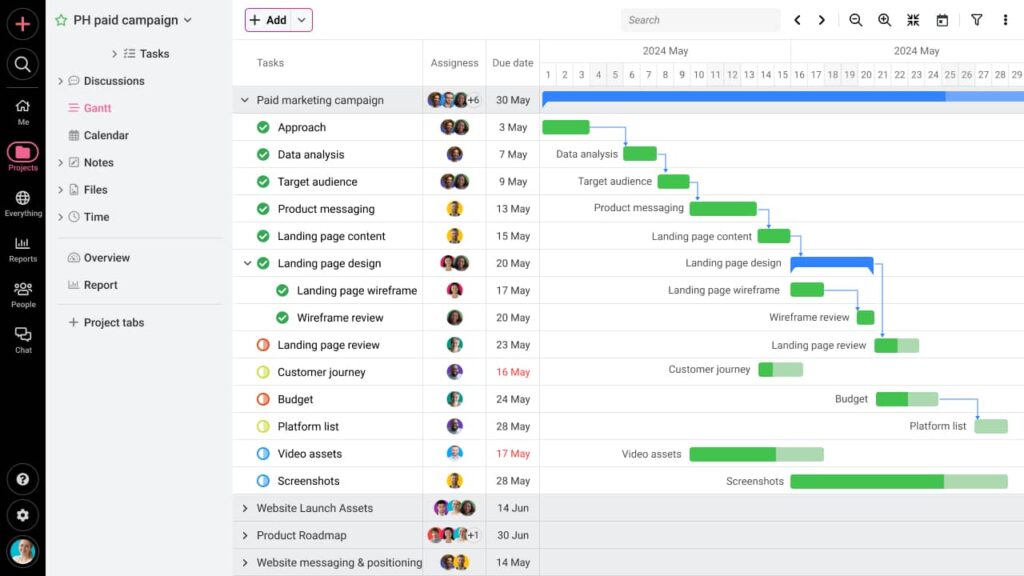
Team members can be assigned to specific tasks, ensuring accountability, while resource allocation demonstrates a well-planned approach.
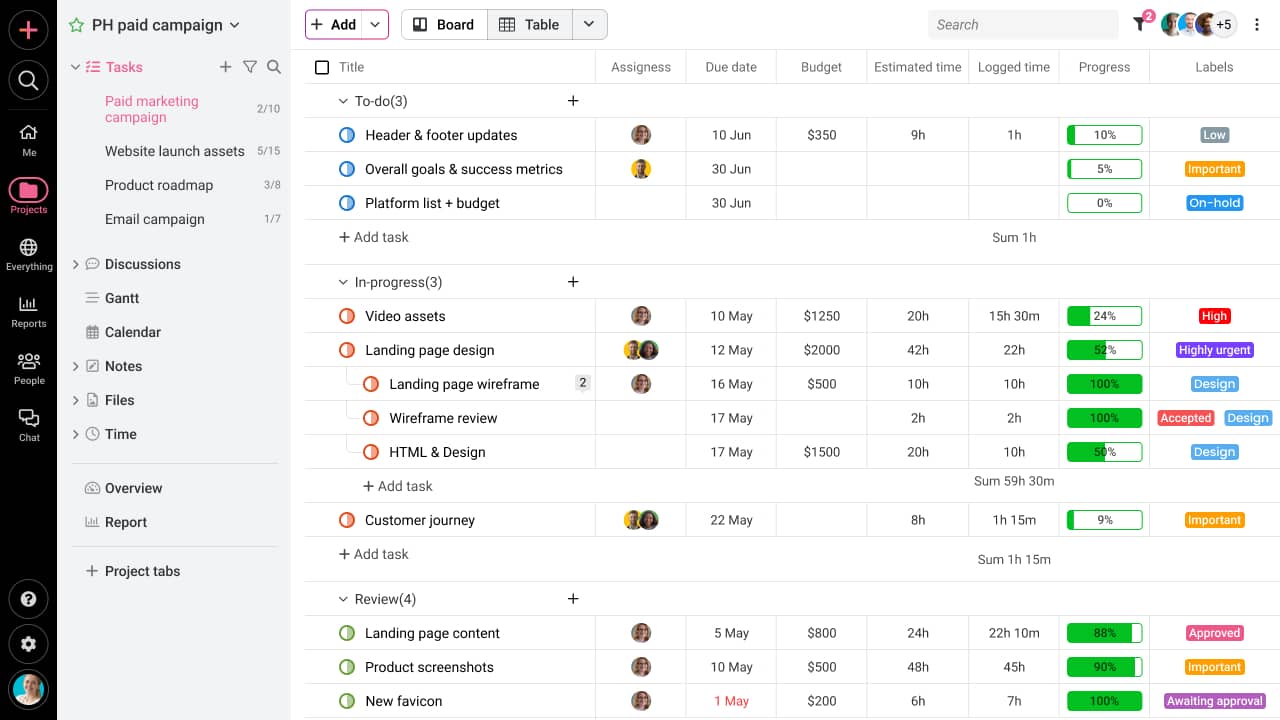
Real-time progress updates, collaborative discussions within tasks, and reporting capabilities showcase transparency and proactive management.

By incorporating ProofHub, your proposal presents a clear picture of efficient execution, giving the reader confidence in your ability to deliver the project successfully.
Learn more about ProofHub’s collaboration capabilities!
7. Project resource requirements
Project resource requirements talk about the resources you need to complete your project which includes materials, human resources, and technology. It is a key section that is crucial for the success of the project because every project needs resources to convert a plan into action.
This section of the project proposal briefly describes the project resources you need for the project and how you are going to utilize these resources.
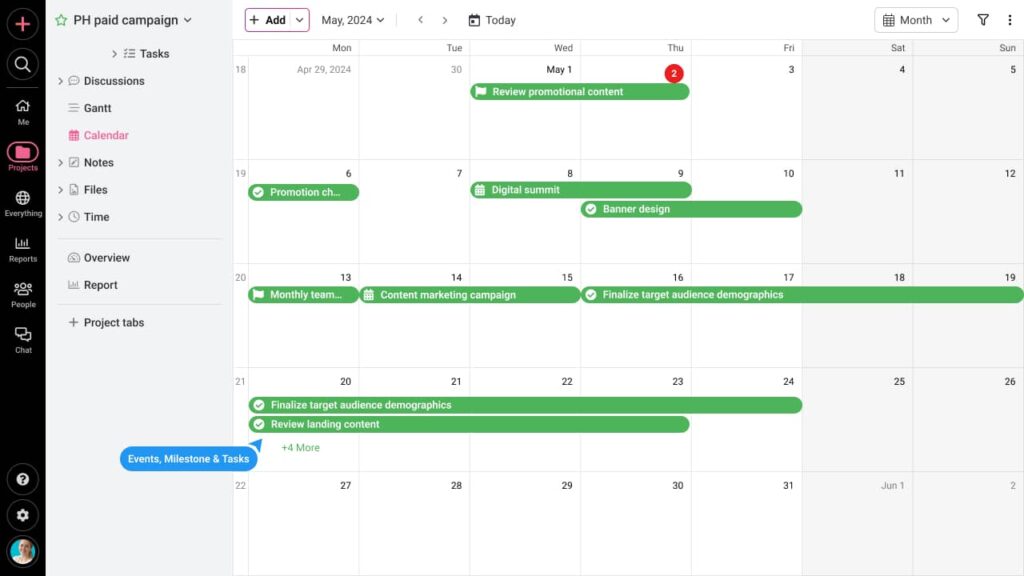
It does not explain the nitty gritty details of resource allocation. But, it gives a fair idea of why you need specific resources for your project and how these will be utilized.
Read more: 2026 guide to project resource management: processes, challenges & tools
8. Estimate project costs and budget
Project resources come at a price. Thus, in this section, you will define the project costs and create a project budget. It is the responsibility of a project manager to write this section in such a way that it covers all the project expenses.
At the same time, it also provides the opportunity for stakeholders to jump in and help you mitigate unexpected costs.
It also includes estimating project costs everything from the cost of project technology to team salaries and materials.
9. Closing statement
At this point of a project proposal, stakeholders have complete information about the project: scope, cost, time, objectives, and impact. You just have to briefly summarize the problem your project addresses and remind stakeholders about the benefits they will get from this project.
You can use cost-benefit analysis to demonstrate why your project is profitable. Thus, in this section, you wrap up your project proposal with a persuasive and confident conclusion to convince stakeholders to close the deal.
I hope these steps help you write a winning project proposal. Now, let’s have a look at some practical tips from experts to write a winning proposal.
Additional tips to write a perfect project proposal
Here are the five practical project proposal tips for writing a proposal:
- Clarity and conciseness: Do not use jargon or make your proposal overly complex. Keep it simple so that project sponsors can understand it easily.
- Strong value proposition: You want your project proposal to be accepted. Give strong emphasis on the benefits of your project and how it addresses the existing problems.
- Compelling visuals: Make your proposal compelling so that project sponsors read it. If it is not persuasive and visually interesting, project sponsors may not read it.
- Proofreading and editing: Do not make silly grammatical mistakes and fact check and proofread your proposal. Wherever required provide statistics to back your claims.
- Use collaboration tools: A project proposal involves explaining about project scope, cost, time, and resources. Use a project management tool like ProofHub to create a plan and collaborate with a team to create an effective project proposal.
Project proposal examples
A project proposal in project management is primarily sent to the stakeholders to secure funding, gain approvals, and request resources from stakeholders.
Here is a real-world example to get an idea of how to write a proposal for a project:
Project Proposal: Implementation of a CRM System to manage company customers, prospects, and leads
1. Executive
The Customer Success Manager at XYZ Corporation is proposing the implementation of a new Customer Relationship Management (CRM) system.
Currently, the company is using a legacy system that makes it difficult to manage data and ensure the alignment between the sales and marketing teams. It results in poor customer service to the customer and missed opportunities.
The new CRM system streamlines the company’s customer interactions, improves data management, and enhances overall customer satisfaction.
This results in enhanced customer relationships, improved operational efficiency, and increased business growth.
2. Background
- Lack of centralized data management system
- Lack of alignment between marketing and sales departments
- Not able to provide exceptional customer experience due to operational inefficiencies
3. Vision
- Implementing CRM to improve customer data management by centralizing all customer information into a single database
- Enhance communication and collaboration among sales, marketing, and customer service teams
- Increase customer satisfaction and retention through personalized and timely interaction
4. Project scope
- Researching and selecting a suitable CRM solution based on the specific needs and requirements of XYZ Corporation.
- Customizing the CRM system to align with the company’s business processes and workflows.
- Migrating existing customer data from legacy systems into the new CRM platform.
5. Project timeline
- Phase 1: Research and Selection (1 week)
- Phase 2: Customization and Configuration (2 weeks)
- Phase 3: Data Migration (1 week)
- Phase 4: Training and Adoption (2 weeks)
- Phase 5: Go-Live and Deployment (2 weeks)
5. Project management approach
Hybrid project management: Waterfall during the planning of each phase of the project and Agile during the implementation of the CRM.
6. Project resource and budget
The estimated budget for the CRM implementation project is $50,000, including software licensing fees, customization costs, training expenses, and implementation services.
7. Project risks and mitigation
Risks:
- Potential resistance from employees toward adopting new technology
- Integration challenges with existing systems and applications:
Mitigation:
- Addressed through providing training sessions for employees to ensure hassle-free adoption of the CRM system.
- Managed through careful planning and coordination with IT vendors and stakeholders.
8. Conclusion
The implementation of a CRM system for XYZ Corporation enhances customer relationships, improves operational efficiency, and drives business growth. We seek approval from the executive management team to proceed with the implementation of the CRM system as outlined in this proposal.
Project management proposal template
Trying to manage a project without project management is like trying to play a football game without a game plan. – Karen Tate
A project management proposal template provides the framework and detailed proposal outlining to create a project proposal. It outlines the sections you need to include in a project proposal and the instructions in each section. By following the instructions in the template, you know how to make a project proposal, customized to your business needs.
Here is the project management proposal template:
1. Executive Summary
In this section, you will summarize the complete project proposal and add the most important details of the project.
Outline the following details in brief in the executive summary:
- Project background and vision
- Project goals and deliverables
- Project budget, timeframe, resource, and success criteria
2. Project Background
In this section, you will talk about the problem a project is going to solve or the business opportunity a project intends to grab. Explain it in-depth because it forms the basis of the project.
Here is what you need to include:
- Project history and stats of similar projects
- The basis upon which the project is created
3. Project vision
This section includes the project vision statement. You explain the solution to the project problem and define the goals of the project.
Here is what you need to do:
- Write a project vision
- Present a solution
- Write the SMART goals you want to achieve
4. Project plan
It includes multiple sections as below:
4.1 Project scope and deliverables
Project scope defines all the work you need to do to complete the project.
Project deliverable is something that is of the end-user or customer value.
4.2 Project timeline
Every project has a start and an end date. Similarly, there is a timeframe for each task and deliverable.
4.3 Project approach
Every project follows an approach to project management and uses project management tools. For example, construction projects follow the Waterfall methodology whereas software development projects follow the Agile methodology.
4.4 Project risks
A project risk is something that can impact the cost, time, and scope of the project.
List here all the project risks, likelihood, impact, mitigation plan, and risk owners in a table.
4.5 Project resource requirements
Project sponsors need to know about the details of the resources required to approve the budget for the Project Proposal.
Define the project resource requirements here in the table:
- Technology requirements
- Human resources requirements
- Material requirements
4.6 Project estimated cost and return on investment
A project sponsor wants to know the project costs and return on investments.
4.7 Project ownership and communication plan
This section includes the details of the key stakeholders of the project.
- Project sponsor: who owns the project
- Project customer: who the project is being delivered to
- Manager: who is responsible for managing the project and informing the status to stakeholders
5. Call to action
In this section, provide your contact details for the client to get in touch with any questions or allow the project sponsor to authorize the project if they are happy with the project proposal.
It is important to keep in mind the above-mentioned are the standard sections that are included in most project proposals. If you want to add some other elements to your project proposal, you can add the sections as per your needs to format a project proposal.
Create a winning project proposal with the right tool
A good project proposal convinces stakeholders why the project should be carried out. It should clearly describe project problems, project objectives, benefits for stakeholders, your requirements from stakeholders, and how you will utilize the secured resources. You need to have a good understanding of the project and project sponsors and stakeholders before writing a project proposal.
To create an effective project proposal, you need cross-functional collaboration between departments to gather key details and project management software to plan a project.
That’s where a feature-rich project management software, ProofHub, comes into play. It helps you with team collaboration and project planning for the project proposal. You can create a project plan using a Gantt chart, create tasks using task management software, and collaborate with the team using chat and a centralized file-sharing system.
FAQs
How long should a project proposal be?
A project proposal should not be too long. Ideally, a project proposal should take 1-2 pages but it also depends on the complexity of the project and the format you choose.
What section of a proposal presents a list of project costs?
Project costs are briefly covered in the Project Cost section. However, it depends on the template you choose. The detailed breakdown of the project costs is attached with the project proposal in the reference document.
What section of a proposal identifies the key issues and discusses the project goals?
Project background and project vision are the sections that talk about the key issues and project goals. However, it is explained in brief in the executive summary also.
